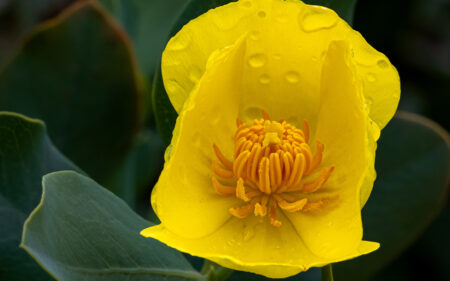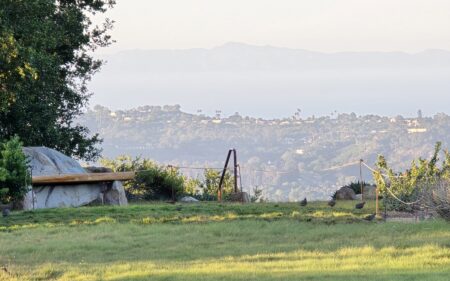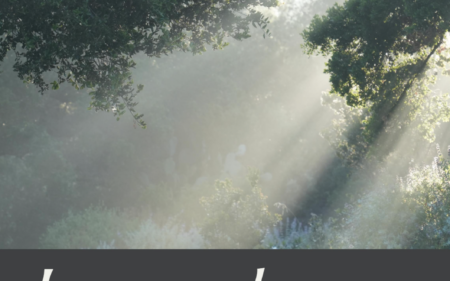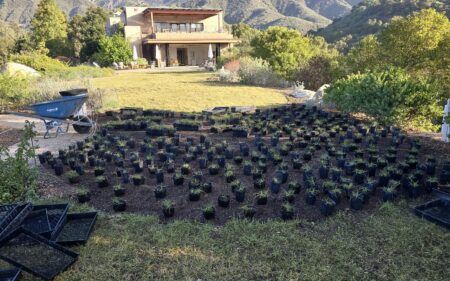Another Way to Listen: Forest Bathing and Nature Connection

I’ve been told tales of people who can hear things in nature that most of us would call “silent.” It’s not just that they have acute hearing and are capable of registering very low decibel levels. It’s a skill that gets developed through deep observation of the natural world and time spent opening oneself to nature’s messages.
The payoff is the ability to hear a cactus bloom, detect the crackle of a sunrise, or to register a rock sort of murmur something nice to a lizard. While these may seem like farfetched occurrences, there is sincerity and even a truth in the effort to listen to our surroundings. If you can suspend your disbelief and make a practice of quietly observing and learning from the natural world around you, I can guarantee you will hear, see, and feel some of the most incredible things you may ever experience.
However, for many of us, cultivating this practice isn’t easy. Hearing a seed germinate might sound outlandish and seeking that sound by sitting outside in silence may seem like folly. But what if I told you those efforts are empirically beneficial to your health? A great body of evidence has accumulated over recent decades suggesting that quiet time in nature can reduce depression and anxiety. Time outside also increases our exposure to phytoncides- compounds that plants broadcast into the air which have been shown to attack pathogens. Simply put, time in nature can increase our emotional and physical well-being. . . regardless of whether you actually hear the unhearable. So, how do we make a shift from not even listening to hearing all of the wonder and miraculous energy of nature?
There is a growing practice of Forest Bathing that encourages us to tune into nature’s many voices and hear what they have to say. Here at The Garden, we have been working with certified Forest Bathing/Forest Therapy instructors who invite participants to quietly engage with the natural world through a series of guided activities and discussions. Since 2019, Elena Rios has facilitated Forest Therapy walks in The Garden as a Certified Nature Forest Therapy Guide through the Association of Nature and Forest Therapy Guides. Elena combines decades of experience as a wildland firefighter with her identity as a Nahua Chicana artist and dancer to connect participants with a deeper sense of place. Ben Page is the founder of Integral Forest Bathing and has served as a Forest Therapy guide since 2015, traveling the globe to share his approach to listening. Ben’s recent book, Healing Trees: A Pocket Guide to Forest Bathing, was published by Simon and Schuster in 2021. We sat down with Elena and Ben to ask them more about their approach to nature connection and how they encourage those around them to listen to nature’s messages.
Please describe what Forest Bathing/Forest Therapy/ Shinrin-Yoku means to you.
Ben: As I receive this question today, my thought is that forest bathing is the practice of being nature, of being what we are. Forest bathing creates a time and a space for us to set aside the stories of ourselves and experience what it feels like to be ecological, to be enmeshed in the world.
Elena: To me, it is rooted in the ancient human practice of nature connection that is reflected in indigenous knowledge all over the world. It speaks to our inter-being, and/or our interdependence on the environment as it relates to overall health and well-being. It is expressed in many different media whether it be through science, language, cultural gatherings, dance, song, poetry, storytelling, art, and more. It is presented in such a way as to welcome all languages and forms of expression in which a rich diverse cross-section of people can relate. My relationship to the practice of nature connection has continued to unfold throughout my life whether as a former wildland firefighter, growing food, or as expressed within the context of my indigenous cultural traditions. I have also been greatly influenced by a 20-year friendship and collaboration with Japanese Shinto Priest Hiroji Seikiguchi.
Can you share a moment where you or one of your participants has experienced a profound connection with nature while forest bathing?
Ben: It’s a funny thing really because I find that the most profound experiences people can have while forest bathing are those that cannot be described in words. When they happen, people feel something deep in their bodies that is somehow ineffable. I have heard people try to describe it as a sense of belongingness, awe, or infinite relationship, but even these terms seem to fall flat of the lived experience itself. Ultimately, I don’t even know if the word ‘profound’ is particularly helpful here, as these kinds of experiences often come through a state of deep attention that is activated by something as simple as seeing a drop of rain falling on a pond, or deeply smelling a flower or hearing wind as it rushes through the trees. These simple kinds of experiences have a certain profundity to them when we remember how to experience them fully, but they may seem profound when one attempts to describe them later. Perhaps the best way to put it is that the most profound experiences that happen on forest bathing walks are simply those when people feel most alive.
Elena: Last spring, I was guiding a family group in the mountains of Ojai, California. Within this group, there was a boy of about 13 or 14 years of age. The smell of sagebrush filled the air, and a red-tailed hawk soared overhead in a seemingly endless blue sky. We gathered together after one of the “sit spot” type invitations, and those who wished to were invited to “share what they noticed.” When it was his turn, he said, “I can feel the Earth breathing.” He said it in such a way as to make us all take pause. It was plain to see this had made a big impression on him, as it had on all of us to witness the telling of this discovery in the way he was experiencing the world in the present moment.


How do Forest Therapy Guides facilitate nature connection? What should someone expect if they sign up for a Forest Bathing program?
Ben: The maxim I work by is that ‘one cannot open a rose with a crowbar.’ To me, this means that I cannot force anyone into having a genuinely authentic connection with nature. I can only create a relaxed and open space for people to find their unique ways of cultivating a relationship. In the story that I hold about forest bathing, everybody knows how to connect with nature. Our bodies know how to activate the senses, as well as how to move, rest, play and interact with the world around us. In truth, our bodies are connected to nature all around us all the time. So, it is not that we are disconnected, but that we are unaware of our interconnection. We don’t often permit ourselves to be in our bodies because we are conditioned to relate to our bodies more as vehicles for our minds than living, breathing ecosystems that have their own intelligence, autonomy, and dignity. And so, the role of the guide is to support participants in orienting their attention towards the body and away from the ruminations of the mind.
Elena: It is pleasurable to allow yourself the experience of being guided. So much of modern life is dictated by schedules and deadlines. People are often surprised at what they notice when they are invited to disconnect from devices, at least for the time being, if they wish. Or, to simply not have to keep track of the time (the guide keeps track for you.) It isn’t so much about knowing the names of the plants, as it is about noticing which plants you feel pulled to. Guides assist people in slowing down and engaging all of their senses. It is more about being here, in the present moment. We do this by giving directions, in the form of invitations, which assist others in dropping into a deeper state of relaxation and connection to nature. And by holding a space that respects the many different ways this can take shape over a broad cross-section of cultures, languages, genders, etc. Sometimes people experience a sort of re-engagement with childlike wonder in nature. Some have transformative realizations or feel creative. Others simply take notice of how much they are enjoying the stillness or the simple luxury of just “being” while soaking up the atmosphere amongst the organic compounds being released into the air like terpenes and immune-boosting phytoncides.



What is some practical advice you can provide for people who want to develop a practice of nature connection but may not know where to start?
Elena: One way to start is by selecting a “sit spot.” It seems to work best when it is a spot that is easily accessible and at a time that presents the least resistance to the rhythm of your day. The backyard of a home, a local park, or an easily accessible trail are all options. But it can also be sitting on the stoop of a building and looking at a tree near the sidewalk, or staring out an apartment window at a tree. Just take a moment to notice the spot that your body feels pulled to. Go there and sit for 10 minutes with no agenda except to silently observe what is going on in your surroundings. Go to this spot a couple of times a week to start. Over time, some people like to journal or sketch what they are noticing. Some people don’t. It is up to you.
I’ve noticed that you deliberately use the word “guide” as a title for someone who facilitates Forest Therapy practice, rather than instructor or teacher. Could you speak to that differentiation?
Ben: A guide holds no expectations for any outcomes and does not aim to impart any particular learning, healing, or transformation to their participants. By contrast, a teacher is often someone who is helping a student gain mastery of a skill or knowledge set that the teacher already possesses. This is not to say that the archetype of the teacher is not a valuable one, but within the context of forest bathing, the teacher (or healer or therapist) is nature itself. Therefore, the guide seeks to create space for each person to arrive at their unique relational process, which may be something that the guide could never have anticipated.
Elena: We refer to ourselves as guides because we are acting as facilitators between the human and the more-than-human world. Together, cultivating a space in which each journey can unfold in a way that makes sense for them. In this way, it offers space that respects and honors the great variety of ways this can emerge. This is different from being told what to experience by someone else, which would imply that there is a “right” or “wrong way” to do it. There is no right or wrong way to go about your practice.
Like mindfulness, the practice of forest bathing asks participants to quiet their distracted inner monologue. Do you have any tips or tricks for folks who are working to settle that internal noise and really be in the moment?
Ben: Don’t try. Don’t work. Don’t strive. Just relax. Simply offer your full attention to the body. Notice what it feels like to breathe, what it feels like when your feet touch the grass, what it feels like to see the clouds moving through the sky. When you are paying attention, not only are you offering a gift to the world around you, but you are also allowing the world to captivate you in such a way that there is no more inner dialogue. It just dissolves into presence. And of course, we never get to a place where we can do this kind of thing perfectly, without thoughts interrupting us now and again, and that’s fine.
What should someone expect from their first session? Any cues that they can look for?
Ben: There’s just no way to know. People experience this practice in a mysteriously personal way, but if I had to cultivate any expectation it would be a space of incredible relaxation, where there is nothing compulsory, nothing to strive for, nothing to attend to.
Elena: Mental health impacts might include less stress, improved mood, less anxiety, relaxation, increased focus, and creativity. Emotional and psycho-spiritual health impacts might include feeling more connected, alive, and present. Experiences such as feelings of gratitude, transformation, a change in perspective, release, and wholeness. The physiological health impacts might include more energy, enhanced immunity, lowered blood pressure, and lower cortisol concentrations. For first responders, it can offer the opportunity to intentionally drop into the parasympathetic nervous system, allowing the body to do the restorative work it needs to bring the best version of yourself to the team or your family between operational assignments.
What’s your experience with Forest Bathing? What got you first interested? What has been the most profound impact in your life since you’ve started your journey with Forest Bathing?
Ben: This is the subject of the first chapter of my book! To put it very succinctly, like many people, I think I was born into the art of forest bathing, though at the time I knew it simply as ‘playing outside.’ The thing that keeps me interested in the practice is also the thing that has most profoundly impacted my life: that forest bathing has helped me understand what it means to be nature. To realize that my body is a part of the interconnected web of life and that the story of my life is somehow interwoven with the stories of all beings, all elements. In short, it’s been a journey of dissolving all notions of separateness between what I call my ‘self’ and the living ecological world.
 Donate
Donate




